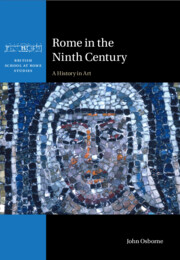Book contents
- Rome in the Ninth Century
- British School at Rome Studies
- Rome in the Ninth Century
- Copyright page
- Contents
- Figures
- Acknowledgements
- Abbreviations
- Ninth-century Popes
- 1 Introduction
- 2 Rome in 800: The Pontificate of Leo III
- 3 Paschal I, the Church of Santa Prassede and the Question of a ‘Carolingian Renovatio’ in Rome
- 4 Paschal I: Other Projects
- 5 Eugenius II, Gregory IV and Sergius II
- 6 The Gathering Storm: The Pontificate of Pope Leo IV (847–55)
- 7 Benedict III, Nicholas I and Hadrian II, and the Continuing ‘Greek’ Presence in Rome
- 8 The Last Hurrah: John VIII (872–82)
- 9 ‘Not with a Bang but a Whimper’
- Afterword
- Bibliography
- Index
5 - Eugenius II, Gregory IV and Sergius II
Published online by Cambridge University Press: 10 October 2023
- Rome in the Ninth Century
- British School at Rome Studies
- Rome in the Ninth Century
- Copyright page
- Contents
- Figures
- Acknowledgements
- Abbreviations
- Ninth-century Popes
- 1 Introduction
- 2 Rome in 800: The Pontificate of Leo III
- 3 Paschal I, the Church of Santa Prassede and the Question of a ‘Carolingian Renovatio’ in Rome
- 4 Paschal I: Other Projects
- 5 Eugenius II, Gregory IV and Sergius II
- 6 The Gathering Storm: The Pontificate of Pope Leo IV (847–55)
- 7 Benedict III, Nicholas I and Hadrian II, and the Continuing ‘Greek’ Presence in Rome
- 8 The Last Hurrah: John VIII (872–82)
- 9 ‘Not with a Bang but a Whimper’
- Afterword
- Bibliography
- Index
Summary
This chapter surveys the engagement with material culture of three popes in the second quarter of the ninth century – Eugenius II, Gregory IV and Sergius II – spanning the years 824 through to 847. Although not as prolific as Paschal I in terms of patronage, all have left at least one significant project to have survived to the present day. Eugenius II’s marble clerical enclosure at Santa Sabina initiates a discussion of stone furnishings in Rome’s early medieval churches; Gregory IV’s apse mosaic in San Marco provides interesting insights into his participation in contemporary ecclesiastic politics in northern Italy, and other initiatives testify to continuing preoccupations with urban infrastructure and the cult of relics; and Sergius II’s newly reconstructed church of San Martino ai Monti attests to the continuing presence in Rome of significant teams of builders and decorators.
Keywords
- Type
- Chapter
- Information
- Rome in the Ninth CenturyA History in Art, pp. 109 - 130Publisher: Cambridge University PressPrint publication year: 2023

